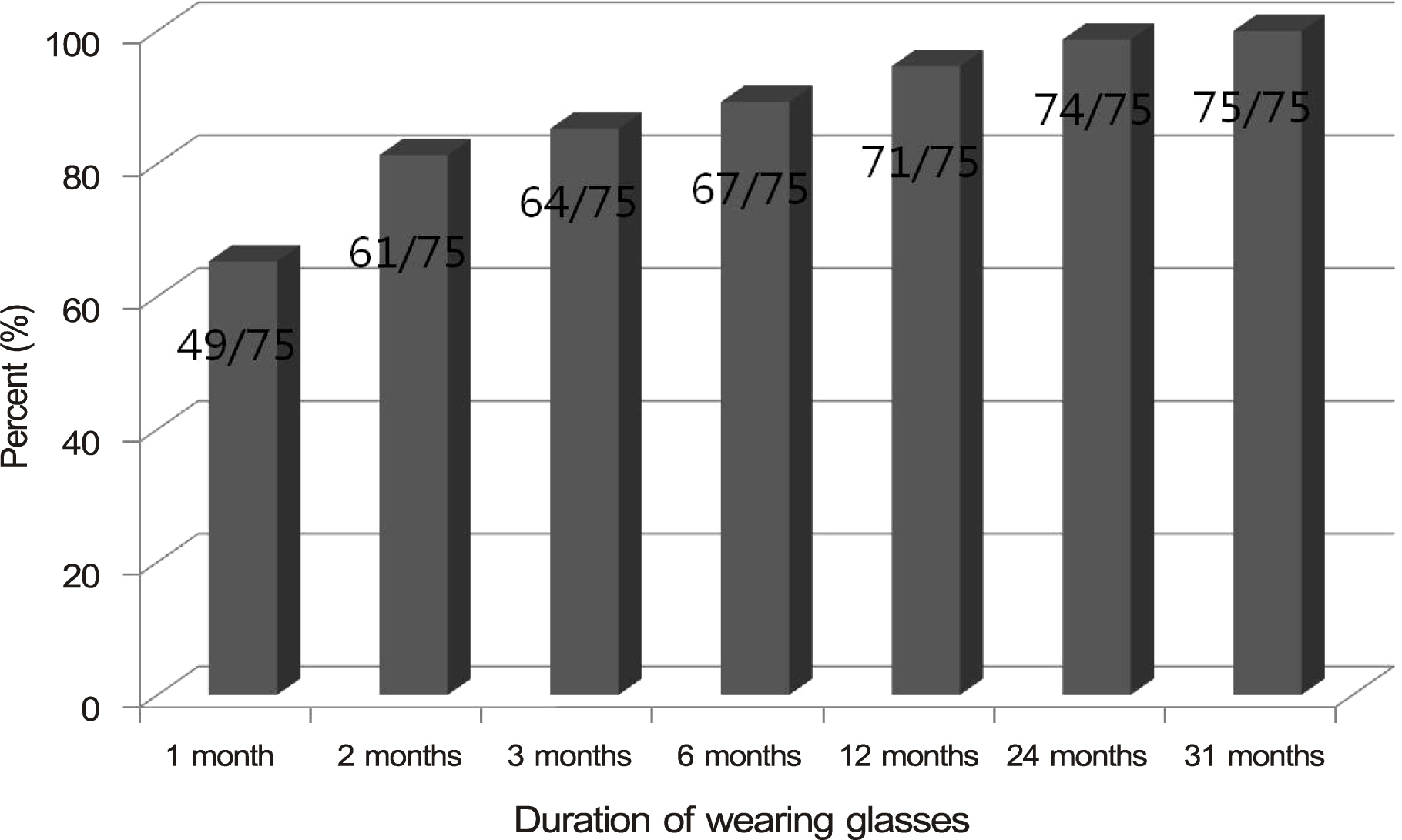J Korean Ophthalmol Soc.
2015 May;56(5):764-770. 10.3341/jkos.2015.56.5.764.
Refractive Accommodative Esotropia: Duration between Wearing Hyperopic Glasses and Control of Esotropia within 8 PD
- Affiliations
-
- 1Sungmo Eye Hospital, Busan, Korea. sunei2@naver.com
- KMID: 2121177
- DOI: http://doi.org/10.3341/jkos.2015.56.5.764
Abstract
- PURPOSE
To report clinical aspects of children diagnosed with refractive accommodative esotropia after wearing their first glasses to correct hyperopia accompanied with esodeviation.
METHODS
The present study included 75 children followed up for at least 24 months. Age, spherical equivalent of refractive error, angle of deviation and presence of amblyopia were analyzed according to the duration between first wearing glasses and control of esotropia within 8 PD (< or =2 months vs. >2 months).
RESULTS
The mean age was 4.48 +/- 2.08 years and mean follow-up was 50.17 months. Initial deviation angle without glasses was 25.43 +/- 10.07 PD at far, 27.72 +/- 11.45 PD at near, spherical equivalent was +4.86 +/- 2.41 D in right eyes, +5.05 +/- 1.06 D in left eyes and 8 of 75 patients (10.67%) had < or =2 D of hyperopia. Esotropia was controlled within 8 PD with hyperopic glasses in 61 of 75 children (81.3%) within 2 months, 6 (8%) within 3-6 months, 4 (5.3%) within 6-12 months and 4 (5.3%) after 12 months. In comparison, esotropia was controlled < or =2 months in 61 of 75 children (81.3%); 14 of 75 children (18.7%) requiring >2 months had less hyperopia (+4.02 D vs. 5.17 D), more severe esodeviation both at far (30.79 +/- 10.79 PD vs. 24.17 +/- 9.56 PD, p = 0.03) and at near distance (34.00 +/- 14.20 PD vs. 26.25 +/- 10.31 PD, p = 0.02) and higher initial amblyopia prevalence rates (71.5% vs. 47.5%).
CONCLUSIONS
Several patients needed longer follow-up until esotropia was controlled within 8 PD after wearing hyperopic glasses considering the amount of hyperopia and angle of esodeviation.
MeSH Terms
Figure
Reference
-
References
1. Von Noorden GK. Binocular vision and ocular motility. 6th ed.St. Louis: Mosby;2002. p. 311–55.2. Wright KW, Spiegle PH. Esodeviations. Wright KW, editor. Pediatric Ophthalmology and Strabismus. 2nd ed.New York: Springer;2003. chap. 13.
Article3. The Korean Strabismus and Pediatric Ophthalmology Society. Esodeviation I. Lee JB, editor. Current Concepts in Strabismus. 1st ed.Seoul: Naewaehaksul;2004. chap. 7.4. Kim C, Hwang JM. The clinical course of esotropia associated with hypermetropia after initial wearing of glasses. J Korean Ophthalmol Soc. 2003; 44:134–43.5. Santiago AP, Ing MR, Kushner BJ, Rosenbaum AL. Clinical strabismus management: principles and surgical techniques. 1st ed.Philadelphia: WB Saunders company;1999. p. 491–505.6. Pollard ZF. Accommodative esotropia during the first year of life. Arch Ophthalmol. 1976; 94:1912–3.
Article7. Baker JD, Parks MM. Early-onset accommodative esotropia. Am J Ophthalmol. 1980; 90:11–8.
Article8. Parks MM. Abnormal accommodative convergence in squint. AMA Arch Ophthalmol. 1958; 59:364–80.
Article9. Sohn HJ, Paik HJ. Clinical features of refractive accommodative esotropia according to the age of onset. J Korean Ophthalmol Soc. 2006; 47:941–6.10. Haynes H, White BL, Held R. Visual accommodation in human infants. Science. 1965; 148:528–30.
Article11. Pollard ZF, Greenberg MF. 20 unusual presentations of accommodative esotropia. J AAPOS. 2002; 6:33–9.
Article12. Coats DK, Avilla CW, Paysse EA, et al. Early-onset refractive accommodative esotropia. J AAPOS. 1998; 2:275–8.
Article13. Manley DR. Strabismus. Harley RD, editor. Pediatric Ophthalmology. 3rd ed.Philadelphia: WB Saunders;1991. p. 139.14. Kwon JY, Lee DE, Song HC. Clinical studies on accormmodative esotropia. J Korean Ophthalmol Soc. 1997; 38:687–91.15. Lim SJ, Lee SY, Lee YC. Change of refractive error in patients with refractive accommodative esotropia. J Korean Ophthalmol Soc. 2007; 48:822–7.16. Jun JH, Lee YC, Lee SY. Clinical features of refractive accommodative esotropia according to degree of hypermetropia. J Korean Ophthalmol Soc. 2008; 49:617–22.
Article17. Gatzonis SD, Follidi VP. The influence of compliance with the use of refractive correction in hyperopic children on accommodation. Eur J Ophthalmol. 2013; 23:876–80. [Epub ahead of print].
Article
- Full Text Links
- Actions
-
Cited
- CITED
-
- Close
- Share
- Similar articles
-
- Refractive Accommodative Esotropia Associated with Mild Hyperopia
- The Clinical Course of Esotropia Associated with Hypermetropia after Initial Wearing of Glasses
- Effect of Age Wearing Prescription Glasses on Changes of Refractive Error in Accommodative Esotropia
- Clinical Features of Refractive Accommodative Esotropia according to the Age of Onset
- Clinical Manifestation of Patients with Accommodative Esotropia for 10 Years


